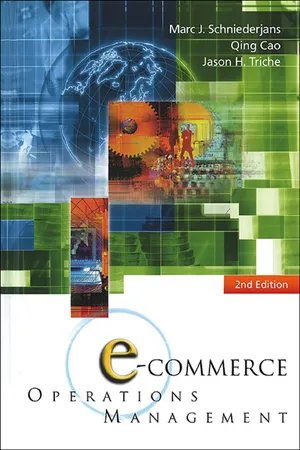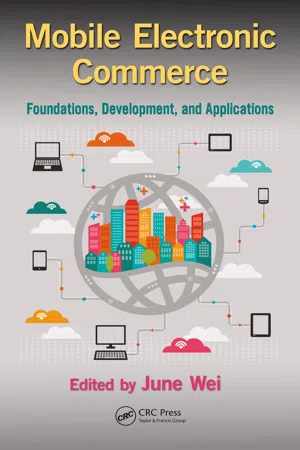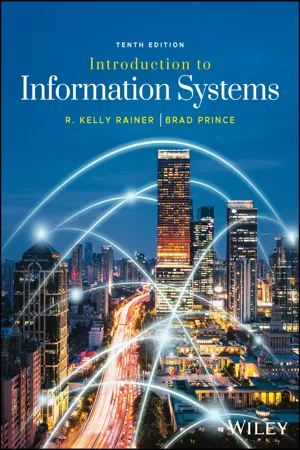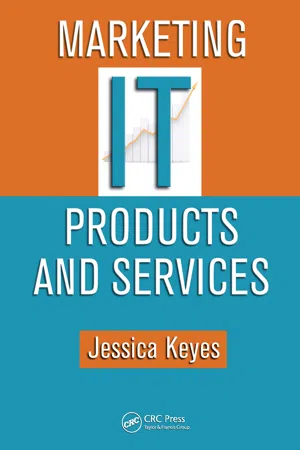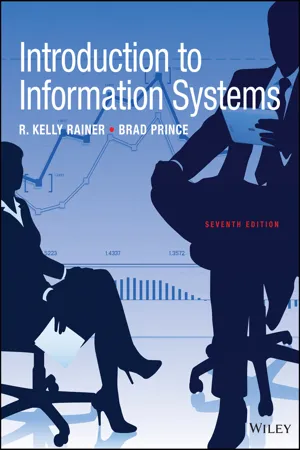Marketing
M-commerce and E-commerce
M-commerce refers to mobile commerce, which involves buying and selling goods and services through mobile devices such as smartphones and tablets. E-commerce, on the other hand, encompasses all forms of commercial transactions conducted electronically over the internet. Both M-commerce and E-commerce are essential components of modern business strategies, enabling companies to reach and engage with customers through digital channels.
Written by Perlego with AI-assistance
Related key terms
1 of 5
8 Key excerpts on "M-commerce and E-commerce"
- eBook - ePub
- Marc J Schniederjans, Qing Cao, Jason H Triche(Authors)
- 2013(Publication Date)
- WSPC(Publisher)
This chapter discusses m-commerce from several perspectives. First, an introduction of m-commerce is discussed with figures of today’s usage and statistics including a brief discussion of the difference between e-commerce and m-commerce. Next, a brief history of m-commerce is examined. Third, the current m-commerce market is discussed. This market is examined from current research, wireless network infrastructure, and user infrastructure. Special attention is given to mobile banking and mobile payment which are two upcoming m-commerce applications.Introduction to M-CommerceAs discussed in previous chapters, e-commerce is defined as buying and selling of products or services over electronic systems. These electronic systems include the hardware, software, and network including the internet or other computer networks. M-commerce is a subset of e-commerce and involves buying and selling of products or services using mobile applications over mobile phones (Coursaris et al. 2002). This definition is a little out of date since newer technologies were invented since this definition was published. This chapter takes a broader definition of m-commerce and includes buying and selling of goods and services on mobile devices anywhere and anytime. This definition does not limit m-commerce to just smart phones, but broadens the devices to tablets, laptops, and Netbooks. M-commerce has two unique qualities over other e-commerce domains: mobility and broad reach (Ngai et al. 2007). Mobility allows users to buy or sell goods and services virtually anywhere anytime. Broad reach means consumers can be reached at any time via their mobile devices.The same issues of trust and security plague m-commerce as it does e- commerce. However, m-commerce is plagued with additional issues like mobile network security, network connectivity and presentation issues. Despite the additional issues for m-commerce, one of the reasons for its amazing growth and popularity is its convenience (Rao et al. - eBook - ePub
- Faizur Rashid, Sadaf Rashid(Authors)
- 2023(Publication Date)
- CRC Press(Publisher)
B2B E-Commerce: E-Commerce between businesses, such as between a manufacturer and a wholesaler or a wholesaler and a retailer, is known as B2B E-Commerce. Most analysts believe that B2B E-Commerce will continue to expand more quickly than other categories.B2C E-Commerce: It is defined as commerce where there is a transaction between the business and the customer. Similar to when you purchase things from an online retailer.B2G E-Commerce: This term is used to describe trade between businesses and the government. It is based on the usage of the internet for government-related tasks including licensing and public procurement.G2B E-Commerce: Instead of private persons, government-to-business (G2B) interactions take place online between local and central government and the commercial business sector (G2C).10.2.2 Role of Digitalization in E-Commerce Markets
The twenty-first century has been dubbed the “golden age of technology.” Smartphones and computers are undeniably the most significant assets that the present generation owns, with significant advancements occurring every year. Furthermore, it has resulted in the formation of important markets, commonly referred to as E-Commerce, in nearly every developed and emerging region of the world. E-Commerce’s contribution to fast-emerging regions like India has been a hot topic of debate around the world, with India being regarded as one of the most potential markets in the future. E-Commerce has grown in importance as a platform for small and major businesses throughout the world to sell their products to new markets.Increased internet penetration, rapid technology adoption, and high sales of technical gadgets such as smartphones and tablets globally have resulted in a large online client base and an unparalleled E-Commerce boom. People are now using the internet and their smartphones to order groceries, clothing, jewelry, furniture, and ordering food by just sitting in their homes.The use of information and technology has become very important to stay ahead in today’s highly competitive market. The younger generation around the world is increasingly using the internet, which presents the potential for online shops. Therefore, most businesses have begun to use the internet to reduce marketing costs and, as a result, lower the price of their products and services on the market. Thanks to the freedom of digitization, consumers save time and effort by buying online because of the cheap internet connections. Many companies are also making use of the internet to convey, communicate, and disseminate information, as well as to sell products, solicit feedback, and run customer satisfaction surveys. - eBook - PDF
Mobile Electronic Commerce
Foundations, Development, and Applications
- June Wei(Author)
- 2014(Publication Date)
- CRC Press(Publisher)
Just as we are gradually starting to gain an under-standing of the unique characteristics of the fixed Internet, a new medium has emerged, the wireless Internet, which raises many of the same ques-tions in a new context (Guerley, 2000). Building successful strategies for the mobile marketplace begins, no doubt, by recognizing the distinctive forces driving the emergence of m-commerce (Senn, 2000). On the Internet, firms can create value for customers in a manner that is different from that which has been achieved in conventional business (Han and Han, 2001). Correspondingly, m-commerce possesses unique characteristics—Keen and Macintosh (2001) call them the mobilization of knowledge—when compared with traditional (i.e., fixed) e-commerce, and many state-ments on an impending m-revolution have, in fact, been triggered by the assumption that the potential of m-commerce will involve (1) lower bar-riers and (2) greater benefits in comparison to both fixed e-commerce and traditional commerce. In view of that, the key question from commerce is to find some way to assess the value of mobile applications to prospective users (Carlsson and Walden, 2002), and to gain an understanding of the factors that may delay the penetration of the mobile Internet on a larger scale (Lee et al., 2001). 280 Mobile Electronic Commerce There are a number of ideas of what is going to constitute the key success factors for the actors in the global m-commerce arena. This arena is already growing diversified with a number of application areas, which are growing in different directions and at different paces. Travel and tour-ism, being one of the largest and most rapidly expanding industries in the world and one of the significant users of ICT in its operations will with-out doubt be one of the trailblazers in the global m-commerce arena with value-added mobile applications. - eBook - PDF
- R. Kelly Rainer, Brad Prince(Authors)
- 2023(Publication Date)
- Wiley(Publisher)
E‐government makes government more efficient and effective, especially in the delivery of public services. An example of G2C electronic commerce is electronic benefits transfer, in which govern- ments transfer benefits, such as Social Security and pension payments, directly to recipi- ents’ bank accounts. • Mobile commerce (m-commerce): The term m-commerce refers to e-commerce that is con- ducted entirely in a wireless environment. An example is using cell phones to shop over the Internet. • Social commerce: Social commerce refers to the delivery of electronic commerce activities and transactions through social computing. • Conversational commerce: Conversational commerce is a type of electronic commerce using natural language processing (see Chapter 14) to engage in various means of conver- sation, such as online chat with messaging apps, chatbots on messaging apps or websites, and voice assistants. Messaging apps include Facebook Messenger (www.messenger.com), WhatsApp (www.whatsapp.com), Kik (www.kik.com), and WeChat (www.wechat.com). Cus- tomers can chat with company representatives, access customer support, ask questions, receive personalized recommendations, and click to purchase, all from within messaging apps. They have the options of interacting with a human representative, a chatbot, or a combination of the two. Facebook Messenger and WeChat are among the largest messag- ing apps in the world. Some 1.3 billion individuals use Facebook Messenger. Facebook’s objective is to drive Messenger users to the more than 40 million businesses with an official brand Facebook page. For example, to shop for a T-shirt on Facebook Messenger, users can send a text to Messenger to start a chat with the mobile shopping app Spring. The app will request information concerning the buyer’s budget and then display several possible T-shirts. If the customer does not like any of these choices, then Spring will present more options. - eBook - PDF
- Jessica Keyes(Author)
- 2009(Publication Date)
- CRC Press(Publisher)
165 14 Chapter E-Commerce as a Sales Medium Electronic commerce (e-commerce) can be defined as business activities conducted using the Internet and the World Wide Web. Generally, people think exclusively of consumer (business-to-consumer or B2C) shopping on the Web as e-commerce, but in fact, business-to-business (B2B) transactions account for a much larger por-tion of revenue generated directly by e-commerce. In addition, business processes that are not directly involved in the selling and purchasing of goods and materials account for the majority of business activities on the Internet. Examples of B2C transactions, such as purchases from Amazon.com, are easy to identify. In these examples, an individual consumer selects and purchases a prod-uct or service over the Internet. B2B transactions are similar, except that they occur between two businesses. For example, a publisher might buy paper from a source over the Internet, or a bookstore might order books from the publisher. Business is not just about buying and selling, and the Internet provides a medium for businesses to exchange information about other processes as well. Product designs and specifications, for example, need to be disseminated to suppliers by a manufacturer. All businesses need to recruit, hire, and manage employees, and all of these processes can be supported by the Internet and related technologies. Advantages of E-Commerce E-commerce can help increase profits by decreasing costs and increasing sales. To increase sales, the Internet provides a medium for reaching a global marketplace 166 ◾ Marketing IT Products and Services affordably. Although it would be expensive to run an ad on every television channel in the United States, a Web site could potentially reach an audience of the same size for much less. In addition, most products are of interest to only a small subsection of the general population, which is known as a market segment. - eBook - PDF
- R. Kelly Rainer, Brad Prince, Cristobal Sanchez-Rodriguez, Sepideh Ebrahimi, Ingrid Splettstoesser(Authors)
- 2023(Publication Date)
- Wiley(Publisher)
Industry analysts esti- mated that Canadian retail sales in 2022 totalled approximately $800 billion. Electronic com- merce accounted for close to 15 percent of these sales, for a total of $109 billion. Significantly, in 2022, e-commerce increased by 13.6 percent over 2021 and 41 percent over 2020. This section examines the basics of e-business and e-commerce. First, we define these two concepts. You will then become familiar with pure and partial electronic commerce and examine the various types of e-commerce. Next, you will focus on e-commerce mechanisms, which are the ways that businesses and people buy and sell over the internet. You will con- clude this section by considering the benefits and limitations of e-commerce. Definitions and Concepts Recall that electronic commerce describes the process of buying, selling, transferring, or exchanging products, services, or information through computer networks, including the internet. Electronic business (e-business) is a somewhat broader concept. In addition to the buying and selling of goods and services, e-business refers to servicing customers, collabo- rating with business partners, and performing electronic transactions within an organization. Electronic commerce can take several forms, depending on the degree of digitization involved. The degree of digitization is the extent to which the commerce has been transformed from physical to digital. This concept can relate to both the product or service being sold and the delivery agent or intermediary. In other words, the product can be either physical or digi- tal, and the delivery agent can also be either physical or digital. In traditional commerce, both dimensions are physical. Purely physical organizations are referred to as brick-and-mortar organizations. (You may also see the term bricks- and-mortar.) In contrast, in pure EC all dimensions are digital. Companies engaged only in EC are considered virtual (or pure-play) organizations. - eBook - PDF
- R. Kelly Rainer, Brad Prince(Authors)
- 2017(Publication Date)
- Wiley(Publisher)
E-commerce enables you to buy from anywhere, at any time. EC ofers a wide variety of products and services, including unique items, ofen at lower prices. The name given to selling unique items is “the long tail.” The long tail describes the retailing strategy of selling a large number of unique items in small quantities. Shoppers can also gain access to very detailed supplementary product information. They can also easily locate and compare competitors’ products and prices. Finally, buyers can find hundreds of thousands of sellers. Two popular online shopping mechanisms are electronic storefronts and electronic malls. As we saw earlier in the chapter, an electronic storefront is a website that represents a single store. Each storefront has a unique uniform resource locator (URL), or Internet address, at which buyers can place orders. An electronic mall, also known as a cybermall, or an e-mall, is a collection of individual shops grouped under a single Internet address. Electronic malls may include thousands of ven- dors. For example, Microsof Bing shopping, (www.bing.com/shopping) includes tens of thou- sands of products from thousands of vendors, as does Amazon (www.amazon.com). Online Service Industries In addition to purchasing products, customers also access needed services on the web. Selling books, toys, computers, and most other products on the Internet can reduce vendors’ selling costs by 20 to 40 percent. Further reduction is dificult to achieve because the products must be delivered physically. Only a few products, such as sofware and music, can be digitized and 202 CHAPTER 7 E-Business and E-Commerce Stripe POM MIS The rapid growth of electronic commerce necessitated a fast, se- cure method for customers to pay online using their credit cards. Traditionally, to process online credit card payments, merchants set up Internet merchant accounts and payment gateway accounts. The merchants obtained their merchant accounts through a bank. - eBook - PDF
- Louis E. Boone, David L. Kurtz, Brahm Canzer(Authors)
- 2021(Publication Date)
- Wiley(Publisher)
Within any e-commerce venture, there are opportunities for marketing, finance, management, procurement, advertising, and distribution specialists. E-commerce provides exposure to product marketing, supply chain, pricing and profit management, customer acquisition, cross-selling, up-selling, customer service, and more. If you’re hoping to launch your own e-commerce site, as an entrepre- neur you will need self-discipline, planning skills, and determination. Outlook As established companies have realized new marketing and sales growth opportunities through e-commerce, and customers have found online shopping to be less expensive, efficient, and time saving, the industry is positioned for further growth. Online selling opportunities continue to grow overseas in China, India, Brazil, Russia, and Southeast Asia. As smart phones continue to prevail over desktops and laptops, mobile commerce is positioned for additional growth. Sources: William Frierson, “Skills You Need for a Career in Ecommerce Store,” College Recruiter, https://www.collegerecruiter.com, accessed July 13, 2018; Brian Fetherstonhaugh, “5 Reasons Why a Career in E-commerce Is Hot Right Now,” LinkedIn, https://www.linkedin.com, accessed July 13, 2018; company website, “What Does It Mean to Study e-Commerce?” World Wide Learn, http://www.worldwidelearn .com, accessed July 13, 2018; Leon Bailey Green, “An Insider’s Guide to Working in e-Commerce,” The Guardian, http://www.theguardian.com, accessed July 13, 2018. 6 The Global Environment for E-Commerce 421 laws. The question, however, is how far they should go. Should they, for instance, allow their websites to be censored? How much should they cooperate with local law enforcement? Assessment Check 1. On which continent is the greatest number of Internet users located? 2. Identify three challenges in the global marketplace for e-businesses.
Index pages curate the most relevant extracts from our library of academic textbooks. They’ve been created using an in-house natural language model (NLM), each adding context and meaning to key research topics.
